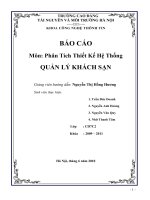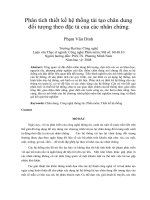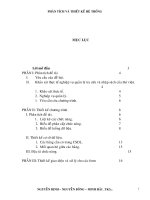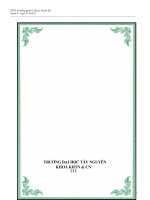Báo cáo phân tích thiết kế hệ thống thư viện
Bạn đang xem bản rút gọn của tài liệu. Xem và tải ngay bản đầy đủ của tài liệu tại đây (4.12 MB, 86 trang )
TRƯỜNG ĐẠI HỌC BÁCH KHOA HÀ NỘI
VIỆN CÔNG NGHỆ THÔNG TIN VÀ TRUYỀN THÔNG
──────── * ───────
BÁO CÁO MÔN HỌC
PHÂN TÍCH VÀ THIẾT KẾ HỆ THỐNG THÔNG TIN
Đề bài: Phân tích, thiết kế hệ thống thư viện
Giáo viên hướng dẫn: TS.Trần Đức Khánh
Sinh viên thực hiện: Nguyễn Quang Dương MSSV: 20090603
Nguyễn Tam Kiên MSSV: 20091512
Phạm Văn Kiên MSSV: 20091523
Lã Thế Long MSSV: 20091644
Trần Thanh Hà MSSV:20090906
Lớp : KTMT&TT-K54
HÀ NỘI - 5/2012
Báo cáo PTTK HTTT
5/2012
2
THÔNG TIN CHUNG
1. Sinh viên thực hiện:
Nguyễn Quang Dương MSSV:20090603 Lớp:KTMT&TT2
Nguyễn Tam Kiên MSSV:20091512 Lớp:KTMT&TT2
Phạm Văn Kiên MSSV:20091523 Lớp:KTMT&TT2
Lã Thế Long MSSV:20091644 Lớp:KTMT&TT2
Trần Thanh Hà MSSV:20090906 Lớp:KTMT&TT2
2. Mục đích bài tập
Phân tích, thiết kế chức năng của hệ thống thư viện.
3. Nội dung thực hiện
Nghiên cứu sơ bộ: nghiên cứu tài liệu nghiệp vụ (business document).
Phân tích nghiệp vụ (business analyse).
Phân tích các ca sử dụng (User case analyse).
Mô hình hóa thành phần dữ liệu: thiết kế sơ đồ thực thể liên kết – ER.
Thiết kế sơ bộ: thiết kế kịch bản, thiết kế đối tượng và thiết kế giao diện người
dùng.
Thiết kế chi tiết: thiết kế chi tiết kịch bản và đối tượng.
Testing: kiểm thử.
4. Kế hoạch sơ bộ
Sử dụng case study trên lớp, tiến độ thực hiện theo bài giảng trên lớp.
Hoàn thành và tổng kết toàn bộ kiến thức trên lớp vào tuần 15.
5. Tài liệu tham khảo
Nguyễn Văn Ba – Phát triển hệ thống hướng đối tượng với UML 2.0 và C++.
Pierre Bourque – Jaimes W.Moore – Software Engineering Body of knowledge
– 2004.
Báo cáo PTTK HTTT
5/2012
3
Tài liệu nghiệp vụ
Business Document là tài liệu mô tả yêu cầu của khách hàng đối với hệ thống phần mềm
được xây dựng và phát triển. Đây là một tài liệu nghiệp vụ về quy trình hoạt động của
một thư viện đã được giao sẵn.
System Requirements of Library System
You are working on a new business system for S City Library. The library wants to
systematize book check-out, return, search and reservation as well as usage status
check. Assume that the library has multiple copies of the same books, each of which is
identified by its book number. The library also wants to offer book search, reservation
and usage status check services to the public over the Internet. S City Library is available
to the public from 9:00 to 18:00.
(1) User registration
- To borrow a book, users first create their “borrower’s cards”.
- They fill out the “borrower’s card application form”, and submit the filled form with
their identification (e.g. health insurance card or driver’s license) to the front counter of
the library.
- The borrower’s card is for use in S City Library only.
- Internet users can access the library system using their accounts and tentative
passwords that are issued when they register as library users. The tentative password
can be changed at any time.
(2) Using the library system via the Internet
- Users can use the library system via the Internet by entering their accounts and
passwords.
- Library staff enter their employee numbers and passwords. They leverage the system to
perform operations of S City Library. Specifically, they can perform book search, check-
out, return, reservation, user registration and usage status check.
- General users enter their borrower’s card numbers and passwords. They can perform
book search, usage status check and reservation.
(3) Borrowing books
- The system processes check-out in units of books.
- The system assigns an administration number (check-out number) to each check-out.
- A user can borrow up to 10 books for 15 days.
- Users bring books they want to borrow, together with their “borrower’s cards”, to the
front counter.









